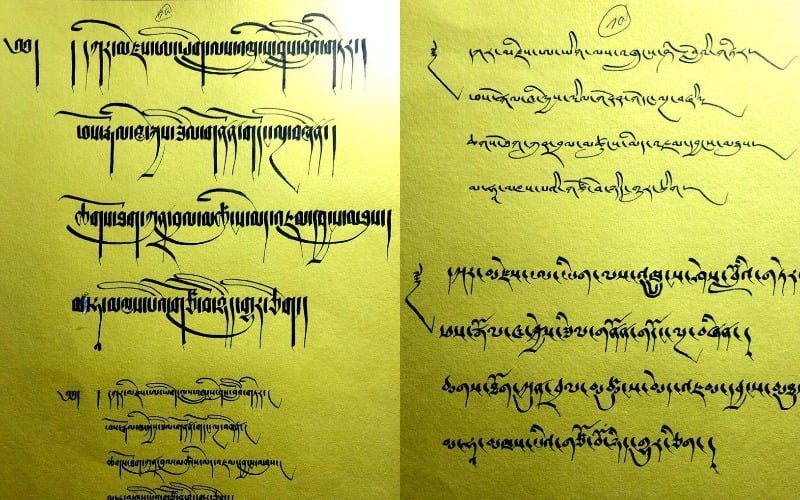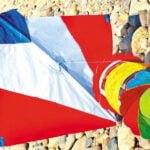Over the centuries, Tibetan calligraphy has greatly evolved, incorporating various writing styles. The two most commonly used styles are U-Chen and U-me. U-Chen, also known as the “Cristated script,” features a horizontal stroke at the top of each letter, with all these strokes parallel to the first top line, giving it a flat cap appearance.
While U-Chen is often associated with printing books, it is also used in handwriting for note-taking and composition writing. In contrast, U-me, known as the “non-Cristated script,” does not require a horizontal line on top of the letters. The main difference between U-Chen and U-me is the presence or absence of the flat cap.
The Jongs style is considered the epitome of the U-Chen script, characterized by its solemn and elegant features. This script employs horizontal, vertical, oblique, and curved lines, with each type of stroke having consistent height, length, pitch, and curve. The writing should appear plump and uniform, with regular spacing between letters, avoiding the use of dotted lines. Consequently, the written text appears orderly and formal, akin to a procession of esteemed guards.

U-me style has seven writing scripts
(1) Petsug script
Petsug is a solemn script used for writing Buddhist texts. When the bottoms of all the letters are neatly cut at the same level, it is known as “neat bottom script”. If the roots of the letters are lengthened with a slight hook stroke, it is referred to as “lengthened root style”. Additionally, there is a combination of Petsug and Drugtsa known as “Petsug script”. Petsug was widely used in Tibet before the introduction of block printing. Numerous ancient Buddhist texts in the Sakya Monastery were written in Petsug and it continues to be popular to this day.
(2) Drugtsa script
Drugtsa, meaning “grain-shaped,” is a script whose main bodies resemble grains. Its vowel writing is akin to Petsug. Drugtsa can be written using long-leg and short-leg letters, with the long-leg style further divided into curved-leg and straight-leg styles. The curved-leg style emerged during the reign of the Sakya Monarch, when official documents, notices, and inscriptions were all written in Drugtsa. An example of this is a preserved ancient royal inscription from the Yuan dynasty in Shandong province.
(3) Tsugring script
Tsugring, also known as the “tall and stable style,” is a form of Tibetan writing characterized by a height of approximately two or three inches. The main body of the text occupies about one inch. In Tsugring, words are written within four lines. The top three lines form the main frame of the word, while the fourth line marks the end of the word’s roots. Practising Tsugring is often the starting point for learning Tibetan writing, as it provides a solid foundation for other script types. Throughout history, calligraphers have created copybooks in Tsugring for children to emulate. One notable calligrapher is Kabab, who served as the secretary for the 13th Dalai Lama. His writings were established as the standard Tsugring copybook for the monastery school in Potala Palace during the 1930s.
(4) Tsugtong script
Tsugtong is the “small and stable style”. It has a structure similar to that of the Tsugring, but with smaller letters, plump main bodies and wider gaps between the words.
(5) Khyuying script
Khyuying is a swift and efficient writing style, also known as the cursive hand. It is a contemporary form derived from Tsugring, specifically developed for rapid information recording. Its introduction marks the advancement of Tibetan calligraphy, requiring mastery of other Tibetan scripts to write Khyuying proficiently.
(6) Tsugkhyu script
Tsugkhyu script combines the solemnity and stability of Tsugtong with the cursive beauty of Khyuying, creating its own unique artistic taste and style. Learning some basic Tibetan words and expressions can be fascinating. Here are a few for your reference.

















